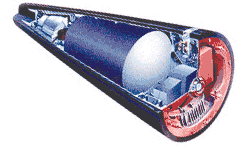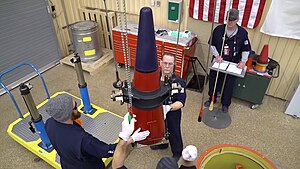W76
| W76 | |
|---|---|
 The W76 warhead and Mk-4 re-entry vehicle (cutaway diagram) – Los Alamos National Labs image | |
| Type | Nuclear weapon |
| Service history | |
| In service | 1978–present |
| Used by | United States and possibly the United Kingdom (see Trident Nuclear Program) |
| Production history | |
| Designer | Los Alamos National Laboratory |
| Designed | W76-0 1973–1978, W76-2 2018 |
| Manufacturer | Pantex Plant |
| Produced | W76-0 1978–1987 (full production), W76-1 2008-2018 (LEP), W76-2 2018-FY2024 |
| No. built | ~3,400 |
| Variants | 3 |
| Specifications | |
| Mass | 95 kg[1] |
Detonation mechanism | Contact, airburst |
| Blast yield | 100 kt (W76-0) 90 kt (W76-1) 5–7 kt (W76-2) |
The W76 is an American thermonuclear warhead, designed for use on the UGM-96 Trident I submarine-launched ballistic missiles (SLBMs) and subsequently moved to the UGM-133 Trident II as Trident I was phased out of service. The first variant, the W76 mod 0 (W76-0) was manufactured from 1978 to 1987, and was gradually replaced by the W76 mod 1 (W76-1) between 2008 and 2018, completely replacing the Mod 0 in the active stockpile. In 2018 it was announced that some Mod 1 warheads would be converted to a new low-yield W76 mod 2 (W76-2) version. The first Mod 2 warheads were deployed in late 2019.
History[edit]
The warhead was initially manufactured from 1978 to 1987 and designed by Los Alamos National Laboratory. It was initially fitted to the Trident I SLBM system, but after the Rocky Flats plant where its successor the W88 was being made was shut down in 1989 after a production run of only 400 warheads, it was decided to transfer W76 warheads to Trident II.[2]
A life extension program (LEP) for 800 warheads was approved by the US government in 2000, then later increased to 2,000.[3] The purpose of the LEP was to extend service life by 20 years and add new safety features. Production on the W76-1 started in September 2008 and the National Nuclear Security Administration completed updating all W76-0 warheads to the W76-1 design in December 2018.[4]
The 2018 Nuclear Posture Review announced that a new variant, the W76-2, would be manufactured.[5] The W76-2 variant is described as a low-yield warhead, estimated at 5-7 kilotons of TNT equivalent.[6] The National Nuclear Security Administration announced that it had started to manufacture the W76-2 in January 2019. Initial operating capability was expected in the final quarter of 2019,[7] and manufacturing is expected to last through FY2024[8] at the Pantex Plant.[9] According to FAS, the W76-2 warhead was first deployed with USS Tennessee during its late 2019 operational patrol.[10] The US Department of Defense confirmed in February 2020 that W76-2 had been 'fielded'.[11]
The warhead is currently the most numerous weapon in the US nuclear arsenal,[12] having replaced the 50 kt W68 that was fitted to the Poseidon SLBM in that capacity.
The United Kingdom operates a nuclear weapon based on the W76 mod-1 design under the name "Holbrook".[13][14]
Design[edit]

The W76-0 had a design yield of 100 kt while its replacement the W76-1 has a yield of 90 kt. The W76-2 has an estimated yield of 5 to 7 kt.[15]
The W76-0 was fitted inside a Mk4 reentry vehicle (reentry body in US Navy parlance) while the W76-1 and -2 are fitted inside the new Mk4A reentry vehicle. Reentry vehicle and warhead weight is estimated to be approximately 95 kilograms (209 lb).[1]
During the W76-1 LEP, the warhead was fitted with a new MC4700 arming, fuzing and firing (AF&F) system. The MC4700 AF&F system increases warhead kill probabilities against hard targets such as silos and bunkers. It achieves this by first calculating the range to the target outside of the atmosphere (i.e. before the atmosphere can alter the warhead's trajectory) and then continuously calculates its position on a line based on acceleration. If the contact fuze is actuated (such as falling short or striking on target) the warhead detonates, but if the fuze calculates it has overshot the target it detonates the warhead before it can leave the kill radius of the target (the kill radius is a sphere, not a circle). In comparison, a warhead without such a smart fuze would when overshooting a target, continue flying, leaving kill radius where detonating would destroy the target, and impact the ground which would actuate the impact fuze and detonate the warhead, outside the kill radius.[16]
See also[edit]
- RSM-56 Bulava – missile in the Russian arsenal with warheads of comparable yield
- List of nuclear weapons
References[edit]
- ^ a b Harvey, John R.; Michalowski, Stefan (21 December 2007). "Nuclear weapons safety: The case of trident". Science & Global Security. 4 (1): 288. doi:10.1080/08929889408426405.
- ^ Sublette, Carey. "The W88 Warhead". Retrieved 7 September 2018.
- ^ Pincus, Walter, "Strategic Plan Extends Life Span Of Nuclear Arsenal", The Washington Post, 19 May 2011, p. 17.
- ^ Work completed on Navy's upgraded nuclear warhead Archived 2021-09-01 at the Wayback Machine. Defense News. 24 January 2019.
- ^ https://media.defense.gov/2018/Feb/02/2001872886/-1/-1/1/2018-NUCLEAR-POSTURE-REVIEW-FINAL-REPORT.PDF Archived 2019-02-08 at the Wayback Machine "Nuclear Posture Review 2018"
- ^ "Trump poised to get new low-yield nuclear weapons". Washington Post. ISSN 0190-8286. Retrieved 2022-11-22.
- ^ "US nuclear weapons: first low-yield warheads roll off the production line". the Guardian. 2019-01-28. Retrieved 2022-11-22.
- ^ "NNSA Plan Shows Nuclear Warhead Cost Increases and Expanded Production". Federation Of American Scientists. Retrieved 2022-11-22.
- ^ Mehta, Aaron (January 28, 2019). "Trump's new nuclear weapon has entered production". Defense News. Archived from the original on September 1, 2021. Retrieved January 29, 2019.
- ^ "US Deploys New Low-Yield Nuclear Submarine Warhead". Federation of American Scientists. FAS. 29 January 2020. Archived from the original on 29 January 2020. Retrieved 29 January 2020.
- ^ Rood, John. "Statement on the Fielding of the W76-2 Low-Yield Submarine Launched Ballistic Missile Warhead". US Dept of Defense. Archived from the original on 4 February 2020. Retrieved 4 February 2020.
- ^ "The W76 Warhead". www.nuclearweaponarchive.org.
- ^ Childs, Nick; Barrie, Douglas (26 March 2021). "The UK and nuclear warheads – stretching credibility?". Millitry Balance Blog. Retrieved 18 October 2022.
- ^ "Nuclear weapons engineering". sandia.gov. Sandia National Laboratories. 2011. Retrieved 18 October 2022.
the first W76-1 United Kingdom trials test was performed at WETL, providing qualification data critical to the UK implementation of the W76-1
- ^ Kristensen, Hans M.; Korda, Matt (29 April 2019). "United States nuclear forces, 2019". Bulletin of the Atomic Scientists. 75 (3): 122–134. Bibcode:2019BuAtS..75c.122K. doi:10.1080/00963402.2019.1606503.
- ^ "How US nuclear force modernization is undermining strategic stability: The burst-height compensating super-fuze". March 2017. Archived from the original on 1 March 2020. Retrieved 8 March 2020.
